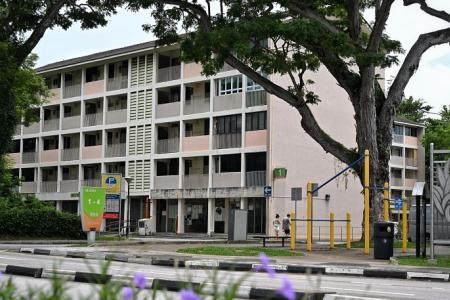60-year-old Siglap HDB block to be preserved for public use
Once slated for demolition, one Housing Board block in East Coast Road could instead be repurposed for community or social use, or could even house new shops, after a recent decision by the authorities to retain the building.
Located across the road from Siglap Centre, the five-storey block is among a cluster of four low-rise HDB blocks that were set to be torn down after it was part of a Selective En bloc Redevelopment Scheme (Sers) project announced in 2011.
Instead, Block 1 East Coast Road will be retrofitted with new features, such as a new lift and staircase, and get a fresh lease of life, after the Singapore Land Authority (SLA) on Sept 24 called a tender for consultants to oversee the building’s refurbishment.
The tender reverses an earlier decision to demolish Block 1. Instead, the authorities now want consultants to turn the vacant building into a “tenantable condition” for social, community and commercial use.
SLA said it wants to do this while “preserving the heritage and collective social memory of the former residential flats”, adding that the internal layout of the block may be reconfigured for its future use.
Meanwhile, the three neighbouring blocks will be torn down, after the Urban Redevelopment Authority (URA) gave HDB the go-ahead on Sept 6 to demolish blocks 2 to 4.
The government agencies’ decision to keep Block 1 is a rare case of an HDB housing block being retained and repurposed for other uses.
While public housing blocks have previously been kept for their heritage value or even conserved, such as the pre-World War II blocks in Tiong Bahru and the central cluster of buildings in Dakota Crescent, those were built by HDB’s predecessor, the Singapore Improvement Trust.
Asked about the decision to retain the block, the URA, SLA and HDB said in a joint statement to The Straits Times that after the four blocks were vacated, studies were done to see how land use could be optimised.
SLA and URA assessed that Block 1 could be retained and repurposed alongside future developments, “remaining a familiar landmark with social memories for residents of the area”, said the statement.
Detailed plans, which include potential social, community and commercial uses, are under study, the statement said. The agencies said SLA’s tender is slated to be awarded in the first half of 2025, with works on Block 1 tentatively scheduled for completion in 2028.
It will join an upcoming integrated development that will replace Siglap South Community Centre as one of the new amenities in the area.
Demolition of blocks 2 to 4 will commence by the first quarter of 2025 and be completed in 2026.
All four blocks, which sit on a site about 0.7ha that is zoned for housing, were completed in November 1963.
They occupy the site of a kampung that was destroyed by a fire that broke out on the first day of Chinese New Year in 1962, displacing 81 families.
At the point of completion, the four blocks comprised 119 flats, 10 shop units and a clinic.
Residents of blocks 1 to 3 were offered replacement flats in Chai Chee Road under the Sers exercise, while Block 4 was previously used for rental housing.
From the time they were built until residents vacated them in 2015, the blocks were the only public housing in Siglap, a private residential enclave.
Mr Ho Weng Hin, co-founder of architectural conservation consultancy Studio Lapis, said the retention of Block 1 is an indication that the authorities have quietly started to consider retaining old HDB-built blocks “for use beyond their original purposes”.
Mr Ho, who is also the founding chair of non-profit heritage group Docomomo Singapore, said the blocks have considerable urban and social significance, given the historical context that led to their construction and the length of time they have stood in East Coast Road.
He suggested interviewing former residents of the blocks, and put up their stories and memories in or around the retained Block 1, for people to appreciate the site’s history.
Mr Gary Ang, who bought a Block 1 flat in the 2000s and lived in it for a few years before selling it prior to the Sers exercise, said he fondly remembers his time living with two relatives as his immediate neighbours – they occupied three flats on the third storey.
Mr Ang, 46, welcomed the retention of Block 1, noting that many of the area’s other landmarks, such as the former Siglap Market that was replaced by Siglap Centre, have since been torn down.
The public servant said many residents in the area are familiar with the old shops in blocks 1 and 2, which included a hairdresser, photography shop and clinic.
“I remember visiting the clinic with my wife to confirm that she was pregnant with our first child,” he said.
Get The New Paper on your phone with the free TNP app. Download from the Apple App Store or Google Play Store now

